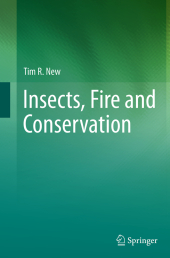 Neuerscheinungen 2016Stand: 2020-02-01 |
Schnellsuche
ISBN/Stichwort/Autor
|
Herderstraße 10
10625 Berlin
Tel.: 030 315 714 16
Fax 030 315 714 14
info@buchspektrum.de |

Tim R. New
Insects, Fire and Conservation
Softcover reprint of the original 1st ed. 2014. 2016. xii, 208 S. 48 SW-Abb., 24 Tabellen. 235 mm
Verlag/Jahr: SPRINGER, BERLIN; SPRINGER INTERNATIONAL PUBLISHING 2016
ISBN: 3-319-38240-3 (3319382403)
Neue ISBN: 978-3-319-38240-1 (9783319382401)
Preis und Lieferzeit: Bitte klicken
A global synthesis of the impacts of wildfires and controlled burning on insects, bringing together much hitherto scattered information to provide a guide to improved conservation management practice. The great variety of responses by insect species and assemblages demonstrates the often subtle balance between fire being a severe threat and a vital management component. Examples from many parts of the world and from diverse biotopes and production systems display the increasingly detailed appreciation of fire impacts on insects in terrestrial and freshwater environments and the ways in which prescribed burning may be tailored to reduce harmful ecological impacts and incorporated into protocols for threatened species and wider insect conservation benefits.
Contents
1 Fire ecology and insect ecology
1.1 Introduction: a perspective of fires
1.2 Fire regimes
1.3 Pyromes
1.4 Plant responses to fire
1.5 Mosaics
1.6 Refuges
1.7 Habitat
1.8 Integration
2 Insect responses to fire
2.1 Introduction
2.2 Impacts and responses
2.3 Pyrophilous insects
2.4 Recovery from fire
2.5 The variety of studies
2.6 Interpreting the outcomes
2.7 Focal groups
3 Sampling and study techniques
3.1 Introduction
3.2 Methods
3.3 Problems with rare species
4 Ecological impacts of fires on insects
4.1 Introduction
4.2 Gradients in herbivory
4.3 Plant vigour
4.4 Interpreting change
4.5 Impacts on freshwater insects
4.6 Climate and scale
4.7 Opportunism: learning from accidents
5 Fires and insect pest management
5.1 Introduction
5.2 Forest pests
5.3 Rangeland pests
5.4 Saproxylic insects
5.5 Invasive ants
6 Fire in threatened species conservation management
6.1 Introduction
6.2 General lessons from examples
6.3 Species: some cases
7 Fire and insect assemblages
7.1 Introduction
7.2 Representative assemblages
7.3 Changes and comparisons
8 Fire as a management component
8.1 Introduction
8.2 Fire in wider management
8.3 Untangling effects
8.4 Fire retardants
8.5 Fire suppression
9 Prospects
9.1 Introduction
9.2 Natural disturbance?
9.3 Prospects for protocols
References
Index
"This book aims to survey current knowledge of the intricate relationships between fire and insect populations and how this knowledge can be applied toward insect management and conservation. ... The well-written book contains numerous graphs, tables, and diagrams, a complete list of references, and a comprehensive index. Summing Up: Recommended. Upper-division undergraduates through professionals/practitioners in fire ecology." (D. L. Richter, Choice, Vol. 52 (9), May, 2015)
Emeritus Professor Tim New is an entomologist with broad interests in insect systematics, ecology and conservation. For long based at La Trobe University, Melbourne, he has travelled widely to collect and study insects in many parts of the world, and his extensive publications on these topics include about 40 books. He is recognised globally as one of the leading advocates for insect conservation.


